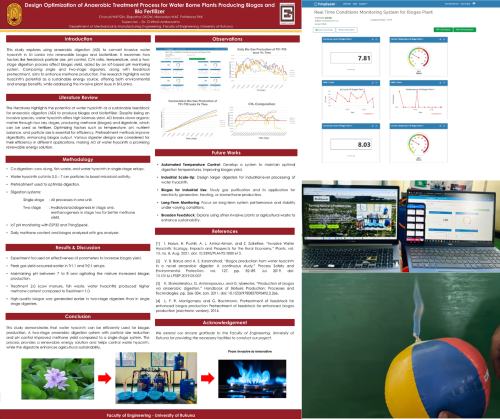Project Abstract
Sri Lanka faces two interlinked challenges: the urgent demand for renewable energy and the ecological damage caused by invasive aquatic species such as water hyacinth (Eichhornia crassipes). This project addresses both by developing and optimizing an anaerobic digestion system to convert water hyacinth into biogas and nutrient rich biofertilizer. The work included the design and fabrication of both single-stage and two-stage digesters, systematic analysis of feedstock particle size on biogas yield, and the integration of an IoT based real time pH monitoring system for precise process control. Experimental trials demonstrated that two-stage digestion, coupled with optimized particle size selection and pH management, achieved significantly higher methane yields and overall stability compared to conventional setups. In addition, the digestate proved valuable as an organic fertilizer, contributing to sustainable agriculture. This project represents how modern engineering can transform ecological threats into sustainable opportunities.
Overview
Water hyacinth, locally known as “Japan Jabara,” has rapidly invaded Sri Lanka’s freshwater bodies, blocking waterways, harming biodiversity, reducing fish stocks, and disrupting agriculture. Its fast growth makes it difficult to control, and methods such as manual removal or biological control provide only short-term relief. This project aimed to convert this invasive plant into a renewable energy resource through anaerobic digestion (AD). By utilizing its high organic content, water hyacinth was tested as a feedstock for biogas and biofertilizer. The work combined the design of single- and two-stage digesters with process optimization through particle size and pH control, supported by IoT-based real-time monitoring. These innovations demonstrate how a problematic weed can be transformed into clean energy, agricultural value, and an environmentally sustainable solution.
Engineering Approach
• Digester Design and Fabrication
Both single-stage and two-stage anaerobic digesters were developed and fabricated. The two-stage configuration separated the hydrolysis/acidogenesis stage from the methanogenesis stage, allowing improved process control and higher efficiency.
• Feedstock Preparation
Water hyacinth was collected from local sources and prepared in selected particle sizes. Experimental trials were conducted to evaluate how particle size influences the breakdown of organic matter and methane yield.
• IoT-Based Process Monitoring
A custom pH monitoring system was developed using ESP32 microcontrollers and connected to the ThingSpeak cloud platform. This allowed continuous monitoring of digester pH, ensuring optimal microbial activity and providing real-time data for process stability.
Results
• Biogas Production: The two-stage digester produced 25–30% higher biogas yield and improved methane concentration compared to the single-stage system under the same operating conditions.
• Process Stability: IoT-enabled real-time monitoring minimized fluctuations, ensuring consistent gas production and avoiding process inhibition due to pH imbalance.
• Byproduct Utilization: The digestate remaining after gas extraction proved to be a high-quality organic fertilizer, providing an additional environmental and economic benefit.
Impact
• Environmental Benefit: Helps control water hyacinth infestations while generating renewable energy.
• Sustainable Agriculture: Supplies nutrient-rich organic fertilizer as a byproduct. • Technological Innovation: Demonstrates the role of IoT in modernizing traditional bioenergy systems.
• Scalability: Provides a practical, community-level model for renewable energy production in rural and semi-urban Sri Lanka.
By integrating process engineering with digital monitoring, this project demonstrates that invasive water hyacinth can be transformed into a resource with tangible energy and agricultural benefits. It highlights how innovative solutions can simultaneously address ecological threats and energy challenges, underscoring the project’s central theme, “Invasive to Innovative.”

